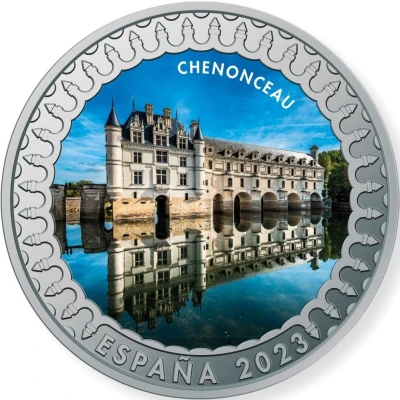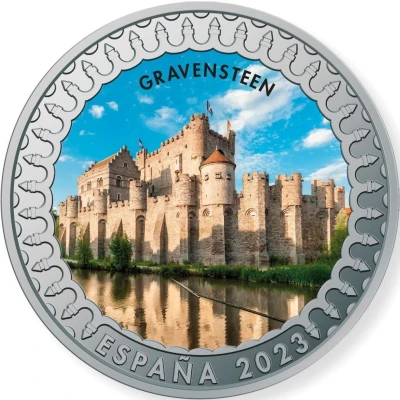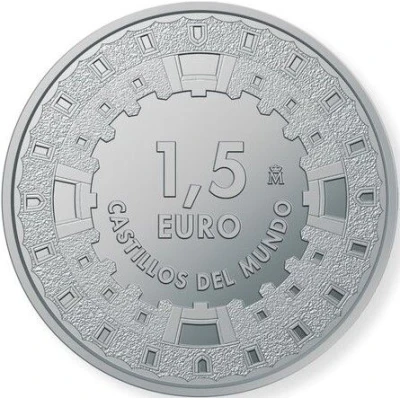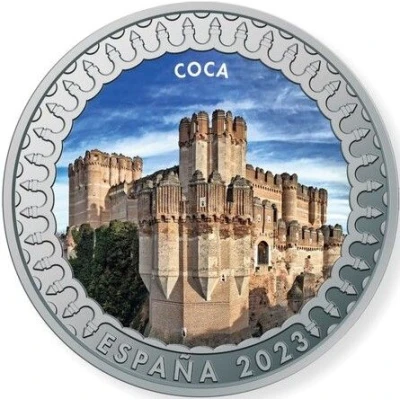
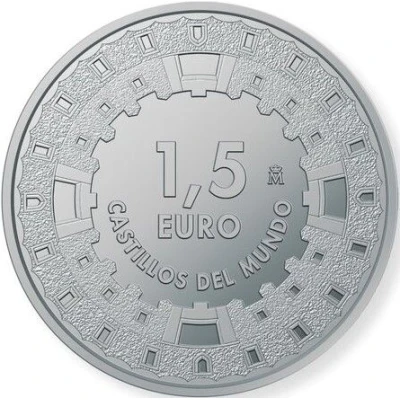

© Real Casa de la Moneda
1.5 Euro Castle of Coca
2023 year| Copper-nickel (75% copper, 25% nickel) | 15 g | 33 mm |
| Issuer | Spain |
|---|---|
| King | Felipe VI (2014-date) |
| Type | Non-circulating coin |
| Year | 2023 |
| Value | 1.5 Euro 1.50 EUR = USD 1.65 |
| Currency | Euro (2002-date) |
| Composition | Copper-nickel (75% copper, 25% nickel) |
| Weight | 15 g |
| Diameter | 33 mm |
| Shape | Round |
| Technique | Milled, Coloured |
| Orientation | Medal alignment ↑↑ |
| Updated | 2024-10-07 |
| Numista | N#383818 |
|---|---|
| Rarity index | 97% |
Reverse
On the outside part of the the reverse (common to all the coins), allegory of the structure of the castles.
Script: Latin
Lettering:
CASTILLOS DEL MUNDO
1,5 EURO
M
Translation: Castles of the World
Edge
Plain
Comment
Castle of Coca: Together with the Alcazar of Segovia, Coca Castle is the jewel in the crown of the Segovian castles and one of the most beautiful in Spain. And it could be said, without exaggeration, that it is also one of Europe’s finest examples of the stately fortified palace style of the 15th century.It is located in the municipality of Coca (formerly the Roman town of Cauca, birthplace of Emperor Theodosius), halfway between Valladolid and Segovia, and stands on the strip of land formed by the confluence of the rivers Eresma and Voltoya.
Coca Castle, according to Lampérez, is a masterpiece of Mudéjar art, a combination of military and palatial architecture that was built in brick by Castilian and Moorish master builders. From a distance, the castle resembles a gigantic organ built of brick, with turrets and battlements, its enormous red mass standing out against the green expanse of the surrounding countryside.
The castle consists of two walled enclosures: the outer circuit being rectangular, almost square, and measuring 70 by 70 metres, with polygonal watchtowers at its corners, together with a pronounced talus rising 10 metres in height; and the inner enclosure, also almost square, of somewhat smaller dimensions and with three polygonal watchtowers at its corners, and an impressive 26-metre-high keep from which you can see the courtyards, moat, barbican, crenellated parapets, the town of Coca and the broad expanse of surrounding pine forests. The complex is surrounded by a huge moat with a perimeter of more than 500 metres, the best moat in the entire region of Castile and León. The defensive wall surrounding the town begins at the castle.
Built by Archbishop Fonseca in the middle of the 15th century, Coca Castle would experience a period of splendour, pomp and circumstance; a period in which, according to legend, at the end of one of the banquets attended by kings and courtiers, Alonso de Fonseca brought out trays piled with jewels so that the queen and her ladies could choose the ones they liked.
After this period of sumptuous opulence, the castle gradually fell into disrepair and neglect, a process that the arrival of Napoleon’s troops intensified by their destruction and plundering, which culminating in the sale in 1828, by the administrator of the House of Alba – to which the castle belonged at the time – of marbles, tiles, capitals and columns, all irretrievably lost.
With ownership passing from the Dukes of Alba to the Spanish Ministry of Agriculture, Coca Castle was rebuilt between 1956 and 1958, and was converted into a forestry school, which it remains to this day. It was declared a National Historic Monument in 1931.
Interesting fact
The Castle of Coca, depicted on the 1.5 Euro non-circulating coin from Spain, is a UNESCO World Heritage Site and one of the best-preserved medieval castles in Spain.
Price
| Date | Mintage | VG | F | VF | XF | AU | UNC |
|---|---|---|---|---|---|---|---|
| 2023 M | 5000 | - | - | - | - | - | - |
Values in the table are based on evaluations by sales realized on Internet platforms. They serve as an indication only for 1.5 Euro (Castle of Coca) 2023 coin.
